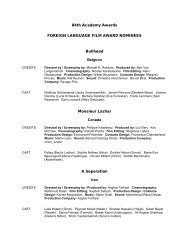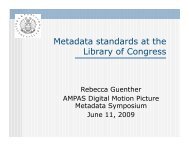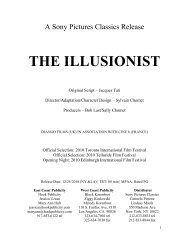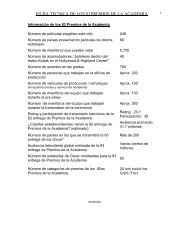Download Report - Academy of Motion Picture Arts and Sciences
Download Report - Academy of Motion Picture Arts and Sciences
Download Report - Academy of Motion Picture Arts and Sciences
Create successful ePaper yourself
Turn your PDF publications into a flip-book with our unique Google optimized e-Paper software.
<strong>of</strong> existing lens equipment <strong>and</strong> on his expectations<br />
<strong>of</strong> future developments.<br />
The dem<strong>and</strong>s <strong>of</strong> the motion picture industry have<br />
driven the lens manufacturers to attempt to supply<br />
lenses <strong>of</strong> a relative aperture which twenty years ago<br />
would have been regarded as impracticable. Progress<br />
in this direction has been attended by much<br />
efiort <strong>and</strong> expense. It is very doubtful whether<br />
the pr<strong>of</strong>its on all the high speed lenses sold are equal<br />
to the money which has been spent in design. But<br />
with all the effort, no essentially new principles <strong>of</strong><br />
lens design have been involved. There is no lens<br />
construction in use today which could not have been<br />
produced twenty or more years ago if the designer<br />
had had the courage to attempt the task, or any reason<br />
to believe that there would have been {ound any<br />
useful application <strong>of</strong> the type o{ lens he could have<br />
produced.<br />
The short focal lengths required in motion picture<br />
work <strong>and</strong> the pictorial character <strong>of</strong> the work<br />
are the factors which have made reasonably high<br />
speed lenses possible. The definition in the image<br />
formed by any lens depends upon the residual aberrations<br />
which still remain after the designer has<br />
done his best with the correction. In general, all<br />
lenses <strong>of</strong> a series <strong>of</strong> focal lengths sold under the<br />
same name are geometrically similar. That is, the<br />
radii <strong>of</strong> curvature <strong>of</strong> the surfaces, the thicknesses <strong>of</strong><br />
the component lenses, <strong>and</strong> the separations <strong>of</strong> the<br />
lenses are usually all exactly twice as great in a 6-<br />
inch as in a 3-inch <strong>of</strong> the same series <strong>of</strong> lenses. It<br />
follows that the numerical value <strong>of</strong> the aberrations<br />
is proportional to the focal length <strong>and</strong> that it may<br />
be easily possible that the quality <strong>of</strong> image produced<br />
by a 2-inch lens may be satisfactory while a 6-inch<br />
<strong>of</strong> the same type might be regarded as useless. Early<br />
photography did not use 2-inch lenses, hence the<br />
designer was wise in regarding F:2.0 lenses, for<br />
example, as impractical. Further, in the early days<br />
<strong>of</strong> the anastigmat nothing was regarded as acceptable<br />
other than the sharpest possible definition. This<br />
attitude has fortunately been ab<strong>and</strong>oned by everyone<br />
but photo-engravers, scientists, engineers <strong>and</strong><br />
others whose work requires for its success the closest<br />
possible approach to absolutely sharp definition.<br />
There is no doubt that absolute sharpness <strong>of</strong> definition<br />
is undesirable in pictorial photography. There<br />
is an equal degree <strong>of</strong> certainty in the mind <strong>of</strong> the<br />
speaker that both in portrait <strong>and</strong> motion picture<br />
photography the departure from sharp definition<br />
has been carried too far to please the general public.<br />
There is no doubt that this has been the result<br />
<strong>of</strong> the enthusiasm with which we are all prone to<br />
receive any new thing, using it without discretion<br />
until our appetites are jaded <strong>and</strong> we relapse into<br />
boredom unless another novelty takes its place. On<br />
the other h<strong>and</strong>, while the question <strong>of</strong> the extent to<br />
which definition should depart from perfection is<br />
debatable there is probably no dissent from the general<br />
proposition that a certain amount <strong>of</strong> s<strong>of</strong>tness<br />
enhances the pleasure we derive from any photograph<br />
intended to appeal to our sense <strong>of</strong> beauty.<br />
These two facts have made the fast lenses possible.<br />
If a higher degree <strong>of</strong> definition be dem<strong>and</strong>ed<br />
<strong>of</strong> the fast lenses it can be attained only by complicating<br />
the construction <strong>and</strong> thereby reducing the<br />
realizable, efiective speed' The economic law <strong>of</strong><br />
"diminishing returns" applies to lens'design as well<br />
as to agriculture or to selling efiorts. A general<br />
dem<strong>and</strong> for better definition than is now possible<br />
can be met only by lenses <strong>of</strong> lower relative aperture'<br />
by lens constructions so complex that the ultimate<br />
result is equivalent to lenses <strong>of</strong> lower aperture, or<br />
by new discoveries in the realm <strong>of</strong> lens design <strong>and</strong><br />
manufacture. In fact, it is reported that existing<br />
high speed lenses fail to show exposures commensurate<br />
with their relative apertures.<br />
Twenty years ago a relative aperture o{ F:4.5<br />
was regarded as very high for anastigmat lenses.<br />
When such lenses were applied to photography it<br />
was found that fore-ground <strong>and</strong> back-ground fell<br />
out <strong>of</strong> focus very rapidly for all but very long shots.<br />
This marked lack <strong>of</strong> depth <strong>of</strong> focus was seized upon<br />
by the salesmen as a mark <strong>of</strong> superiority' They<br />
claimed it added depth or plasticity, stereoscopic<br />
efiect, to present the principal object in sharp focus<br />
against an out-<strong>of</strong>-focus back ground, making a virtue<br />
out o{ a defect, as salesmen in all lines <strong>of</strong> merch<strong>and</strong>ise<br />
are prone to do. The public accepted this<br />
view for a time, but the public is today more inclined<br />
to independent judgment as to what is good<br />
<strong>and</strong> bad photography, having been largely educated<br />
therein by the marvelous accomplishments <strong>of</strong> the<br />
cinematographers. The public today is not pleased<br />
by photography in which the {ore ground <strong>and</strong> back<br />
ground are masses <strong>of</strong> haze. It was suggested in<br />
one <strong>of</strong> the meetings <strong>of</strong> last week, <strong>and</strong>, I believe,<br />
there is truth in the suggestion, that lack <strong>of</strong> depth<br />
<strong>of</strong> focus is <strong>of</strong>ten responsible for criticism <strong>of</strong> the<br />
general or ayerage definition <strong>of</strong> a picture.<br />
Depth <strong>of</strong>. focus, if there were no other considerations<br />
involved, sets a limit to the speed to which it<br />
is desirable to carry lens design. Just what that<br />
limit is in cinematography I cannot definitely say<br />
for it is a matter o{ opinion how much blurring <strong>of</strong><br />
the fore ground <strong>and</strong> back ground should be per*<br />
mitted. Undoubtedly it should vary with the character<br />
<strong>of</strong> the set. If flexibility in lighting be permitted,<br />
a much more extensive use <strong>of</strong> the diaphragm<br />
than is common today would improve the technique<br />
<strong>of</strong> the cameraman.<br />
In view <strong>of</strong> the above <strong>and</strong> other considerations into<br />
which time will not permit us to go, it is questionable<br />
whether better average photography would not<br />
result from the use <strong>of</strong> lenses <strong>of</strong> somewhat less aperture<br />
than is now employed.<br />
In addition to the quality <strong>of</strong> the image produced<br />
by a lens the focal length <strong>of</strong> it is an important factor<br />
in determining the character <strong>of</strong> the picture as it<br />
appears to observers in the theatre. All sets are<br />
three-dimensional <strong>and</strong> the arrangement <strong>of</strong> the actors<br />
<strong>and</strong> properties in respect <strong>of</strong> their relative distances<br />
from the camera contributes nearly as much to the<br />
final efiect <strong>of</strong> composition as do their separations in<br />
f53 I
















